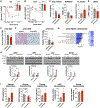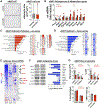The rheumatoid arthritis drug auranofin lowers leptin levels and exerts antidiabetic effects in obese mice
- PMID: 36243005
- PMCID: PMC9742315
- DOI: 10.1016/j.cmet.2022.09.019
The rheumatoid arthritis drug auranofin lowers leptin levels and exerts antidiabetic effects in obese mice
Abstract
Low-grade, sustained inflammation in white adipose tissue (WAT) characterizes obesity and coincides with type 2 diabetes mellitus (T2DM). However, pharmacological targeting of inflammation lacks durable therapeutic effects in insulin-resistant conditions. Through a computational screen, we discovered that the FDA-approved rheumatoid arthritis drug auranofin improved insulin sensitivity and normalized obesity-associated abnormalities, including hepatic steatosis and hyperinsulinemia in mouse models of T2DM. We also discovered that auranofin accumulation in WAT depleted inflammatory responses to a high-fat diet without altering body composition in obese wild-type mice. Surprisingly, elevated leptin levels and blunted beta-adrenergic receptor activity achieved by leptin receptor deletion abolished the antidiabetic effects of auranofin. These experiments also revealed that the metabolic benefits of leptin reduction were superior to immune impacts of auranofin in WAT. Our studies uncover important metabolic properties of anti-inflammatory treatments and contribute to the notion that leptin reduction in the periphery can be accomplished to treat obesity and T2DM.
Keywords: auranofin; inflammation; insulin sensitivity; leptin reduction; obesity.
Copyright © 2022 Elsevier Inc. All rights reserved.
Conflict of interest statement
Declaration of interests The authors declare no competing interests.
Figures







References
-
- Bachman ES, Dhillon H, Zhang CY, Cinti S, Bianco AC, Kobilka BK, and Lowell BB (2002). betaAR signaling required for diet-induced thermogenesis and obesity resistance. Science 297, 843–845. - PubMed

